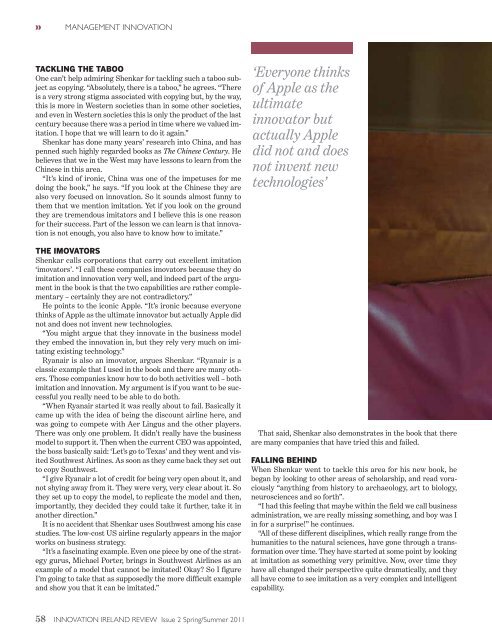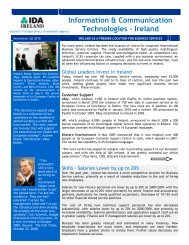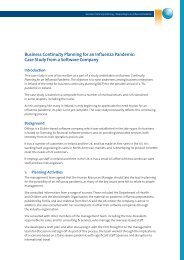Creativity - IDA Ireland
Creativity - IDA Ireland
Creativity - IDA Ireland
Create successful ePaper yourself
Turn your PDF publications into a flip-book with our unique Google optimized e-Paper software.
» MANAGEMENT INNOVATION<br />
TACKLING THE TABOO<br />
One can’t help admiring Shenkar for tackling such a taboo subject<br />
as copying. “Absolutely, there is a taboo,” he agrees. “There<br />
is a very strong stigma associated with copying but, by the way,<br />
this is more in Western societies than in some other societies,<br />
and even in Western societies this is only the product of the last<br />
century because there was a period in time where we valued imitation.<br />
I hope that we will learn to do it again.”<br />
Shenkar has done many years’ research into China, and has<br />
penned such highly regarded books as The Chinese Century.He<br />
believes that we in the West may have lessons to learn from the<br />
Chinese in this area.<br />
“It’s kind of ironic, China was one of the impetuses for me<br />
doing the book,” he says. “If you look at the Chinese they are<br />
also very focused on innovation. So it sounds almost funny to<br />
them that we mention imitation. Yet if you look on the ground<br />
they are tremendous imitators and I believe this is one reason<br />
for their success. Part of the lesson we can learn is that innovation<br />
is not enough, you also have to know how to imitate.”<br />
THE IMOVATORS<br />
Shenkar calls corporations that carry out excellent imitation<br />
‘imovators’. “I call these companies imovators because they do<br />
imitation and innovation very well, and indeed part of the argument<br />
in the book is that the two capabilities are rather complementary<br />
– certainly they are not contradictory.”<br />
He points to the iconic Apple. “It’s ironic because everyone<br />
thinks of Apple as the ultimate innovator but actually Apple did<br />
not and does not invent new technologies.<br />
“You might argue that they innovate in the business model<br />
they embed the innovation in, but they rely very much on imitating<br />
existing technology.”<br />
Ryanair is also an imovator, argues Shenkar. “Ryanair is a<br />
classic example that I used in the book and there are many others.<br />
Those companies know how to do both activities well – both<br />
imitation and innovation. My argument is if you want to be successful<br />
you really need to be able to do both.<br />
“When Ryanair started it was really about to fail. Basically it<br />
came up with the idea of being the discount airline here, and<br />
was going to compete with Aer Lingus and the other players.<br />
There was only one problem. It didn’t really have the business<br />
model to support it. Then when the current CEO was appointed,<br />
the boss basically said: ‘Let’s go to Texas’ and they went and visited<br />
Southwest Airlines. As soon as they came back they set out<br />
to copy Southwest.<br />
“I give Ryanair a lot of credit for being very open about it, and<br />
not shying away from it. They were very, very clear about it. So<br />
they set up to copy the model, to replicate the model and then,<br />
importantly, they decided they could take it further, take it in<br />
another direction.”<br />
It is no accident that Shenkar uses Southwest among his case<br />
studies. The low-cost US airline regularly appears in the major<br />
works on business strategy.<br />
“It’s a fascinating example. Even one piece by one of the strategy<br />
gurus, Michael Porter, brings in Southwest Airlines as an<br />
example of a model that cannot be imitated! Okay? So I figure<br />
I’m going to take that as supposedly the more difficult example<br />
and show you that it can be imitated.”<br />
‘Everyone thinks<br />
of Apple as the<br />
ultimate<br />
innovator but<br />
actually Apple<br />
did not and does<br />
not invent new<br />
technologies’<br />
That said, Shenkar also demonstrates in the book that there<br />
are many companies that have tried this and failed.<br />
FALLING BEHIND<br />
When Shenkar went to tackle this area for his new book, he<br />
began by looking to other areas of scholarship, and read voraciously<br />
“anything from history to archaeology, art to biology,<br />
neurosciences and so forth”.<br />
“I had this feeling that maybe within the field we call business<br />
administration, we are really missing something, and boy was I<br />
in for a surprise!” he continues.<br />
“All of these different disciplines, which really range from the<br />
humanities to the natural sciences, have gone through a transformation<br />
over time. They have started at some point by looking<br />
at imitation as something very primitive. Now, over time they<br />
have all changed their perspective quite dramatically, and they<br />
all have come to see imitation as a very complex and intelligent<br />
capability.<br />
58 INNOVATION IRELAND REVIEW Issue 2 Spring/Summer 2011

















